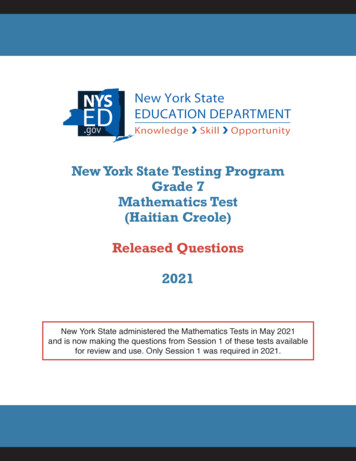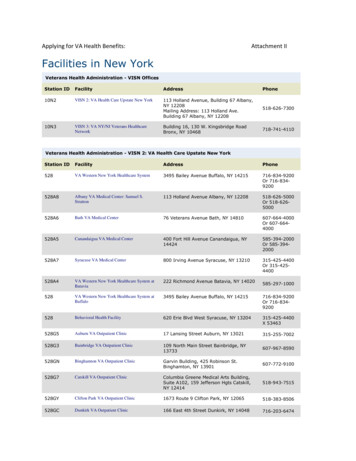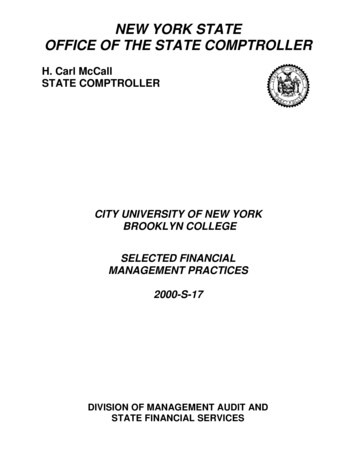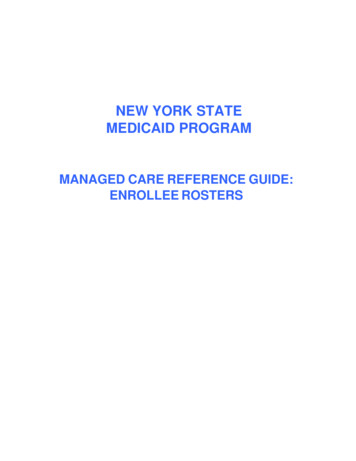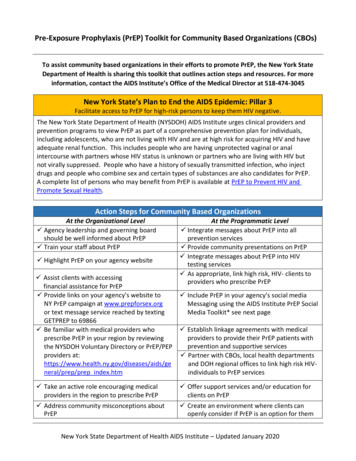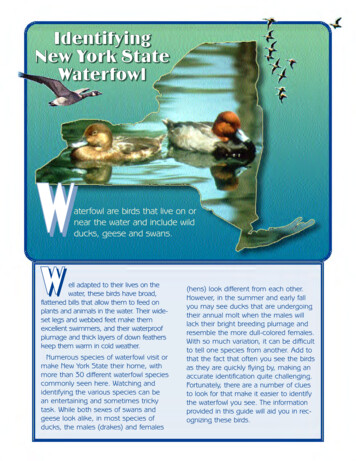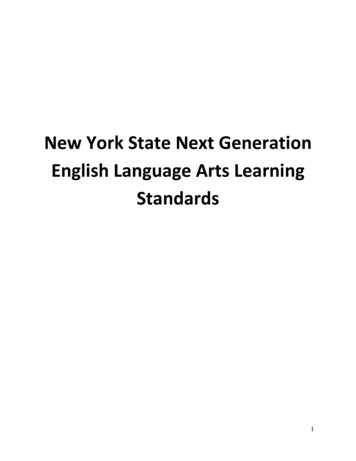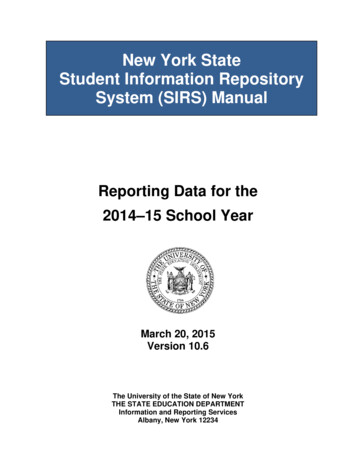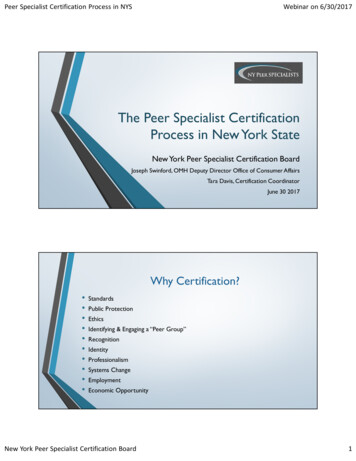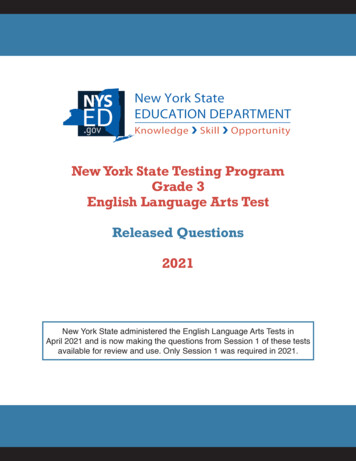
Transcription
New York State Testing ProgramGrade 3English Language Arts TestReleased Questions2021New York State administered the English Language Arts Tests inApril 2021 and is now making the questions from Session 1 of these testsavailable for review and use. Only Session 1 was required in 2021.
THE STATE EDUCATION DEPARTMENT / THE UNIVERSITY OF THE STATE OF NEW YORK / ALBANY, NY 12234New York State Testing ProgramGrades 3–8 English Language ArtsReleased Questions from 2021 TestsBackgroundIn 2013, New York State (NYS) began administering tests designed to assess student performance inaccordance with the instructional shifts and rigor demanded by the new New York State P–12Learning Standards in English Language Arts (ELA). To help in this transition to new assessments,the New York State Education Department (NYSED) has been releasing a number of test questionsfrom the tests that were administered to students across the State in the spring. This year, NYSEDis again releasing 2021 NYS Grades 3–8 English Language Arts and Mathematics test materials forreview, discussion, and use.In February 2021, with the ongoing COVID-19 pandemic still forcing restrictions on all educationaland learning activities statewide, NYSED submitted two federal waiver requests related to stateassessment and accountability requirements. The waiver requests addressed the uniquecircumstances caused by the pandemic that have resulted in many students receiving some or allof their instruction remotely.Later that month, the United States Department of Education (USDE) informed states that it wouldnot grant a blanket waiver for state assessments. However, the USDE agreed to uncouple stateassessments from the Every Student Succeeds Act (ESSA) accountability requirements so that testresults will be used solely as a measure of student learning. Additionally, it was decided that NYSEDwould administer only Session 1 of the Grades 3–8 ELA and Mathematics Tests for the Spring 2021administration and that the tests would include previously administered questions.The decision to use previously administered test questions in this extraordinary year was based onguidance from nationally recognized experts in the assessment field and was recommended in apublication from the Council of Chief State School Officers to state education departments. Reusingtest questions provided the benefit of having established scale scores and stable item parameters.Using previously administered test questions also ensured that it will be possible to develop newtest forms for 2022 and beyond. Although it was not the driver of the decision, the reuse ofpreviously administered test questions provided an opportunity for cost savings during theseunique circumstances where the instructional models used by schools varied throughout the State.For 2021, the entire Session 1 booklet is being released as this is all that students were requiredto take. Additionally, NYSED is providing information about the released passages; the associatedtext complexity for each passage; a map that details what learning standards each releasedquestion measures; and the correct response to each question. These released materials willhelp students, families, educators, and the public better understand the tests and NYSED’sexpectations for students.
Understanding ELA QuestionsMultiple-Choice QuestionsMultiple-choice questions are designed to assess the New York State P–12 Learning Standards inEnglish Language Arts. These questions ask students to analyze different aspects of a given text,including central idea, style elements, character and plot development, and vocabulary. Almostall questions, including vocabulary questions, will be answered correctly only if the studentcomprehends and makes use of the whole passage.For multiple-choice questions, students select the correct response from four answer choices.Multiple- choice questions assess reading standards in a variety of ways. Some ask students toanalyze aspects of text or vocabulary. Many questions require students to combine skills. Forexample, questions may ask students to identify a segment of text that best supports the centralidea. To answer these questions correctly, a student must first comprehend the central idea andthen show understanding of how that idea is supported. Questions tend to require more than roterecall or identification.New York State P–12 Learning Standards AlignmentThe alignment to the New York State P–12 Learning Standards for English Language Arts is intendedto identify the analytic skills necessary to successfully answer each question. The releasedquestions do not represent the full spectrum of how the standards should be taught and assessed inthe classroom. It should not be assumed that a particular standard will be measured by anidentical question in future assessments. Specific criteria for writing test questions, as well asadditional assessment information, are available at http://www.engageny.org/common-coreassessments.
2021 Grade 3 ELA Test Text Complexity MetricsFor Released QuestionsSelecting high-quality, grade-appropriate passages requires both objective textcomplexity metrics and expert judgment. For the Grades 3–8 assessments based on theNew York State P–12 Learning Standards for English Language Arts, both quantitative andqualitative rubrics are used to determine the complexity of the texts and their appropriateplacement within a grade-level ELA exam.Quantitative measures of text complexity are used to measure aspects of text complexitythat are difficult for a human reader to evaluate when examining a text. These aspectsinclude word frequency, word length, sentence length, and text cohesion. These aspectsare efficiently measured by computer programs. While quantitative text complexitymetrics are a helpful start, they are not definitive.Qualitative measures are a crucial complement to quantitative measures. Usingqualitative measures of text complexity involves making an informed decision about thedifficulty of a text in terms of one or more factors discernible to a human reader applyingtrained judgment to the task. To qualitatively determine the complexity of a text,educators use a rubric composed of five factors; four of these factors are required andone factor is optional. The required criteria are: meaning, text structure, languagefeatures, and knowledge demands. The optional factor, graphics, is used only if a graphicappears in the text.To make the final determination as to whether a text is at grade-level and thusappropriate to be included on a Grades 3–8 assessment, New York State uses a two-stepreview process, which is an industry best-practice. First, all prospective passages undergoquantitative text complexity analysis using three text complexity measures. If at least twoof the three measures suggest that the passage is grade-appropriate, the passage thenmoves to the second step, which is the qualitative review using the text-complexityrubrics. Only passages that are determined appropriate by at least two of threequantitative measures of complexity and are determined appropriate by the qualitativemeasure of complexity are deemed appropriate for use on the exam.For more information about text selection, complexity, and the review process pleaserefer lexity-grades-9-12
Degrees ofReading Power*Flesch-KincaidFlying on IceExcerpt from Nature's Fireworks: A BookAbout LightningExcerpt from Crabbing for SupperMeet the TeacherExcerpt from Just the Right GiftDon't Touch Me!WordCount643458LexilePassage TitleReading MaturityMetric*Text Complexity Metrics for 2021 Grade 3 opriate* Depending on when the passage was selected, either the Reading Maturity Metric or Degrees of Reading Power wasused as the third quantitative metric.New York State 2021 Quantitative Text Complexity Chart for Assessment and CurriculumTo determine if a text’s quantitative complexity is at the appropriate grade level, NewYork State uses the table below. In cases where a text is excerpted from a large work, onlythe complexity of the excerpt that students see on the test is measured, not the largework, so it is possible that the complexity of a book might be above or below grade level,but the text used on the assessment is at grade level. Because the measurement of textcomplexity is inexact, quantitative measures of complexity are defined by grade bandrather than by individual grade level and then paired with the qualitative review by –10th11th–12thATOS2.75 – 5.144.97 – 7.037.00 – 9.989.67 – 12.0111.20 – 14.10Degrees ofReadingPower42 – 5452 – 6057 – 6762 – 7267 – 74Source: Student Achievement PartnersFlesch-Kincaid1.98 – 5.344.51 – 7.736.51 – 10.348.32 – 12.1210.34 – 14.20The LexileFramework420 – 820740 – 1010925 – 11851050 – 13351185 – 1385ReadingMaturity3.53 – 6.135.42 – 7.927.04 – 9.578.41 – 10.819.57 – 12.00SourceRater0.05 – 2.480.84 – 5.754.11 – 10.669.02 – 13.9312.30 – 14.50
GRADE 3ELASESSION 1Name:New York StateTesting ProgramEnglish Language Arts TestSession 1Gradev202r7LJReleased Questions
“Flying on Ice” by Valerie Hunter, Spider, January 2016. Used with permission of Carus Publishing Company via Copyright ClearanceCenter.Excerpt from Nature’s Fireworks: A Book About Lightning by Josepha Sherman. Copyright 2004 by Josepha Sherman. Used withpermission via Copyright Clearance Center.Excerpt from “Crabbing for Supper” by Laurel Sheridan, Spider, March 2016, p. 13–17. Used with permission of Carus Publishing Companyvia Copyright Clearance Center.Developed and published under contract with the New York State Education Department by Questar Assessment Inc., 5550 Upper 147thStreet West, Minneapolis, MN 55124. Copyright 2021 by the New York State Education Department.Session 1
Session 1TIPS FOR TAKING THE TESTHere are some suggestions to help you do your best: Be sure to read all the directions carefully. ost questions will make sense only when you read the whole passage. You may readMthe passage more than once to answer a question. When a question includes a quotationfrom a passage, be sure to keep in mind what you learned from reading the wholepassage. You may need to review both the quotation and the passage in order to answerthe question correctly. Read each question carefully and think about the answer before making your choice.Session 1Page 1
Read this story. Then answer questions 1 through 6.Flying on Iceby Valerie Hunter1Craig watched his older sister, Riley, and her friend Liz race up anddown the lake on their skates, dodging the other hockey players. eirskate blades looked like silver smoke.2When the game was over, the girls skated up to the bench where Craigwas sitting. Craig asked Riley what skating felt like.3“When I go really fast, I feel like I’m flying,” she said.4 at’s silly, thought Craig. Flying is something birds do in the air, notsomething people do on ice skates. en he watched Riley go back out onthe ice. She skated around and around the edge of the lake with her armspumping and her scarf trailing behind her. Soon she was going so fast thather arms looked like wings and her scarf looked like a feathery tail. Maybeskating really was like flying.5When Riley sat down to take her skates off, Craig said, “I wish I couldfly.”6Riley retied her skate laces and crouched next to Craig. “Get on myback,” she said, and Craig did. Riley started skating, but Craig didn’t feellike he was flying. It just felt like a wobbly piggy-back ride.7“You’re too heavy,” Riley said. “I can’t go fast when I’m carryingyou.” She skated slowly back to the bench. Craig got off her back.8“Even if you could go fast, I wouldn’t be flying,” he said sadly. “I needskates to fly.”9Riley didn’t say anything on the walk home, but a few days later sheasked Craig if he wanted to go skating.1011“To watch?” he asked.“No, to skate,” she said cheerfully. “Mom and I found a pair of my oldskates. ey might fit you.”GO ONPage 2Session 1
skates. ey might fit you.” e skates were a little big, but when Riley stuffed newspaper in the toes,12they fit. Craig couldn’t stop smiling. He didn’t want to take them off, buthe had to so he could walk to the lake.13Riley and Liz went with him. ey carried their hockey sticks, twoorange cones, and a wooden chair. When they got to the lake, Craig put hisskates back on and Riley helped him onto the ice. en she put his handson the back of the chair.14“Hang on to this and you won’t fall,” she said. “Just push it along in frontof you, OK?”15Craig grinned. “OK.” His feet felt wobbly, but he held on to the chair andhe didn’t fall. Riley and Liz cheered him on as he started to move forward. en they set up the cones and practiced passing the puck to each otherand shooting goals.16Craig watched them. ey made skating look easy. He tried to skate likethem, but when he let go of the chair he fell. So he grabbed on to it againand inched along. His skate blades went scritch scritch scritch instead ofthe swish swish sound that his sister’s blades made. is wasn’t like flyingat all. It was like being a snail.17“Ready to go home?” Riley finally asked.18Craig nodded, frowning. Riley had never said how hard skating was.19“What’s wrong?” she asked.20“I wanted to skate like you,” Craig said. “I wanted to fly.”21“Someday you will,” Riley said. “It takes practice.” She patted hisshoulder. en she whispered something to Liz, who grinned and winkedat Craig. Each girl took one of Craig’s hands.22“Someday you’ll fly on your own,” Riley said. “But today Liz and I willhelp you.”23Riley and Liz started skating, pulling Craig with them. e edges of hisskate blades just touched the ice. e girls went faster and faster, and so didhe. When he looked down, his skate blades were a silver blur. His hatnearly blew off.24“I’m flying!” he yelled, and the words blew away in the wind like a bird’shappy song.GO ONSession 1Page 3
123What does the word “crouched” mean as it is used in paragraph 6?Aspun aroundBbent downCstood upDfell overIn paragraph 9, what is the most likely reason Riley stays quiet as she and Craig walkhome?AShe is thinking about how well she played hockey.BShe is upset with Craig because he hurt her back.CShe is thinking about how to get skates for Craig.DShe is tired from skating in the hockey game.What does paragraph 12 help the reader understand about Craig?ACraig is too young to learn how to skate.BCraig is very excited about learning to skate.CCraig is unable to take the skates off by himself.DCraig is worried that his sister will take the skates back.GO ONPage 4Session 1
456In paragraph 16, what does the phrase “like being a snail” help the reader to understandabout Craig?AHe skates very slowly.BHe moves in a crooked line.CHe searches for a place to hide.DHe looks like all the other skaters.Which sentence best describes how paragraph 6 relates to paragraph 23?AParagraph 6 provides a problem and paragraph 23 provides asolution.BParagraph 6 asks a question and paragraph 23 provides an answer.CParagraph 6 provides a cause and paragraph 23 shows an effect.DParagraph 6 provides similarities and paragraph 23 shows differences.Which sentence best describes a central message of the story?AChange is normal and an important part of life.BFriendships o en become stronger over time.CNew experiences can be exciting and wonderful.DNatural talent is more important than practice.GO ONSession 1Page 5
Read this passage. Then answer questions 7 through 12.Excerpt from Nature’s Fireworks:A Book About Lightningby Josepha Sherman12Flash! Lightning streaks from a dark cloud.Crash! under shakes our roofs and windows. A lightning stormdazzles the sky like flickering fireworks.Lightning Begins3High above the ground, water droplets and ice crystals swirl and swarminside the moving clouds. e tiny particles bump into one another. Whenthe particles rush together, they become charged. Electricity is created.Lightning is Electricity4A single stroke of lightning carries millions of volts of electricity. Eachstroke heats the air in its path to as much as 50,000 degrees Fahrenheit(27,760 degrees Celsius). at is five times as hot as the surface of the sun.GO ONPage 6Session 1
Lightning Around the World8Every day, lightning flashes from thousands of thunderstorms aroundthe world. Every second, more than 100 lightning bolts hit the ground.Lightning can strike a tree or dry grass. When this happens, a wildfire canstart. Lightning bolts can hit tall buildings. ey also can hit electricaltowers, houses, and cars.9Flash! Lightning is streaking through the clouds. Every flash is anotherdisplay of nature’s fireworks.Fast Facts10It does not have to be raining outside for lightning to strike. Lightningcan strike both before and a er the rain falls, or even when there is no rainat all. Lightning helps nature by putting nitrogen into the ground and air.Nitrogen is a nutrient. at means it feeds plants and helps them grow.Safety Tips11Windows, water faucets, pipes, telephones, and electrical outlets can bedangerous when there is lightning in the sky. You should not run water ortalk on the phone if you see lightning. You could get an electrical shock.12Benjamin Franklin once flew a kite in a lightning storm. at is how helearned about electricity. But today, we know lightning is very dangerous. Ifyou see lightning, you should go indoors right away.GO ONPage 8Session 1
789According to paragraph 5, what happens right before thunder can be heard?ALittle drops of water move around in the sky.BDark clouds appear in the sky.CRain droplets start to fall from the clouds.D e air spreads because of heat from lightning.What is the main idea of paragraph 6?ALightning can reach from the sky to the ground.BA bolt of lightning can travel up to nine miles.CFlashes of lightning can jump from one cloud to another.DLightning can move over large distances very quickly.Which idea from the passage does the second illustration best support?ALightning can be helpful for nature.BLightning moves very quickly.CLightning appears in different ways in the sky.DLightning may strike before or a er it rains.GO ONSession 1Page 9
101112What does the word “nutrient” mean as it is used in paragraph 10?Aa type of lightningBa supply of heatCa kind of plantDa form of foodWhich question does the section “Fast Facts” help to answer?AHow does lightning help the earth?BHow is lightning different in the summer?CHow is electricity created in clouds?DHow can someone avoid an electrical shock?Which sentence shows a cause and effect relationship that is stated in the passage?APeople see lightning before they hear thunder.BWildfires can start when lightning touches the ground.CHeat from electricity is hotter than the surface of the sun.DLightning bolts can hit tall trees and buildings.GO ONPage 10Session 1
3“Here.” Paulie handed me the baited string. “Dangle this down in thewater to call the crabs.”4Crabs love stinky old fish, so our first crab didn’t take long to come. Itsbig claw clamped the bait, and I raised the string real slow so Paulie couldnet it. But my legs swishing in the water startled that crab, and it let go andfloated back to the bottom like a leaf off a tree. Paulie brought up the netand stood there with the handle on the dock. . . .5I went back to dangling the fish.6“Well, get ready,” he urged. “Here comes another one.”7 e sun was hot on our backs. My clothes were already sticking to me,and sweat trickled down our faces. A fly buzzed around my head. Iremembered what Paulie had said and sat perfectly still as the new crabclamped onto the fish. But as Paulie scootched forward on his belly tolower the net, he knocked a pebble off the dock and scared that crab away,too. . . .8“Crabs are scaredy-cats,” I said, pulling up the line to check the bait.“ is smells disgusting. How can they eat this?”9“I don’t know. How can Mom and Dad eat broccoli casserole? I reallyhate that stuff,” Paulie moaned.1011“Me, too,” I said. “Blech!”We thought about the big pot waiting and Dad dropping the crabs intothe spicy, boiling water. ey would turn a beautiful bright red a er a fewmoments, and we’d have a crab feast, cracking the shells and pulling outthe sweet white meat. We had to keep trying. I smacked a mosquito offPaulie’s arm and dangled the bait some more. We squinted past the sun’sreflection on the water.12“Sit still now. Here comes another one,” said Paulie.13He inched the net into the water.14“Got him!”15Paulie hauled up the net with the crab inside, but that crab was all clawsand those mad pincers were waving all over the place!“Look out!” I screamed, but the crab’s big claw already had hold ofGO ONPage 12Session 1
1617“Look out!” I screamed, but the crab’s big claw already had hold ofPaulie’s finger.“Ow! OW! Get him off! Get him off!”18Paulie hopped around, shaking his hand up and down, swinging thatcrab all over the place.19I yelled, “Let go!” but the crab didn’t seem to understand English.Finally, Paulie swung his arm in a giant arc, and the crab landed back inthe water. Paulie’s finger was all red and puffy. I could tell he was tryingnot to cry.20“What should we do now?” I asked.21We both thought about broccoli casserole.22“Keep trying,” said Paulie, dunking his sore finger into the cold water.23But the harder we tried, the darker it got. When the sun began to set, wecouldn’t see into the water anymore. We heard Mom yell from the house,“Bring all you’ve got and come on in now.”24Paulie let go of the string and wiped his hands clean on his shorts as thestinky bait sank to the bottom.25“Guess what’s for supper,” I sighed.26“Broccoli, here we come,” Paulie groaned.2728“Remember to get the bucket with the spare bait,” I reminded him,slumping along with the net dragging behind me.Suddenly, Paulie grabbed my arm. “Listen,” he whispered.29Noises came from the bucket Paulie was carrying. We leaned in close,but it was too dark to see.30“What’s all that scratching?” I asked. We ran through the sand to thelight of the screened-in porch.31“Well, would you look at that?” exclaimed Paulie with a high-five. ere,in the bucket, was a mountain of beautiful blue crabs fighting over ourextra fish.32“Let’s go!” I yelled.33We raced to give Dad the crabs.“Whoa!” he said. “You caught a lot!”GO ONSession 1Page 13
34“Whoa!” he said. “You caught a lot!”35“Great!” Mom said. “Well, I don’t think that the le over casserole willkeep for another day . . .” She started scraping the broccoli into the garbagedisposal.36I looked at Paulie. “Yes!” we mouthed silently to each other with hugegrins.GO ONPage 14Session 1
131415What does the word “clamped” mean as it is used in paragraph 4?AsmelledBloweredCmovedDgrabbedWhich detail from the story best shows the narrator’s point of view about catchingcrabs for supper?A“My clothes were already sticking to me, and sweat trickled down ourfaces.” (paragraph 7)B“ is smells disgusting. How can they eat this?” (paragraph 8)C“. . . cracking the shells and pulling out the sweet white meat. We hadto keep trying.” (paragraph 11)D“. . . but that crab was all claws and those mad pincers were waving allover the place!” (paragraph 15)Which detail from the story best shows why Paulie and the narrator keep trying to catcha crab?A“Crabs love stinky old fish, so our first crab didn’t take long to come.”(paragraph 4)B“ ‘Crabs are scaredy-cats,’ I said, pulling up the line to check the bait.”(paragraph 8)C“I could tell he was trying not to cry.” (paragraph 19)D“We both thought about broccoli casserole.” (paragraph 21)GO ONSession 1Page 15
161718What happens right before Paulie and the narrator reach the porch in paragraph 30?A ey learn that they will have broccoli casserole for dinner.B ey hand a bucket of crabs to their father.C ey find out that something is moving in the bucket.D ey hear their mother calling them to come home.How does paragraph 31 connect to the problem in paragraph 26?AIt shows the solution to the problem.BIt gives an effect of the problem.CIt explains the cause of the problem.DIt gives an example of the problem.What best states the lesson of paragraphs 27 through 31?AHard work and a strong will can solve almost any problem.BGood things can happen even when all hope seems lost.CStaying calm is important when faced with a problem.DWorking with and trusting others can help to finish any job.STOPPage 16Session 1
Grade 3English Language Arts TestSession 1v202
THE STATE EDUCATION DEPARTMENTTHE UNIVERSITY OF THE STATE OF NEW YORK / ALBANY, NY 122342021 English Language Arts Tests Map to the StandardsGrade 3 Released QuestionsQuestionSession 1123456789101112131415161718TypeMultiple ChoiceMultiple ChoiceMultiple ChoiceMultiple ChoiceMultiple ChoiceMultiple ChoiceMultiple ChoiceMultiple ChoiceMultiple ChoiceMultiple ChoiceMultiple ChoiceMultiple ChoiceMultiple ChoiceMultiple ChoiceMultiple ChoiceMultiple ChoiceMultiple ChoiceMultiple ChoiceKeyBCBAACDDCDABDCDCABPoints .RL.3.2StrandSubscoreLanguage StandardsReading Standards for LiteratureReading Standards for LiteratureReading Standards for LiteratureReading Standards for LiteratureReading Standards for LiteratureReading Standards for Informational TextReading Standards for Informational TextReading Standards for Informational TextReading Standards for Informational TextReading Standards for Informational TextReading Standards for Informational TextReading Standards for LiteratureReading Standards for LiteratureReading Standards for LiteratureReading Standards for LiteratureReading Standards for LiteratureReading Standards for gReadingReadingReadingReadingReadingThis item map is intended to identify the primary analytic skills necessary to successfully answer each question on the 2021 operational ELA test.Secondary Standard(s)
THE STATE EDUCATION DEPARTMENT / THE UNIVERSITY OF THE STATE OF NEW YORK / ALBANY, NY 12234 . New York State Testing Program Grades 3–8 English Language Arts. Released Questions from 2021 Tests. Background. In 2013, New York State (NYS) began admi
